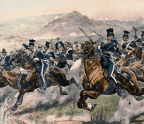


The Wehrmacht invaded Norway with the swiftness of a spring wind and violence of an eagle rending its prey. German Fallschirmjägers, making the first opposed airborne assault in history, landed at desolate Sola Air Station just after dawn on April 9, 1940. Behind them in successive waves came more than 1,000 Luftwaffe aircraft, six army divisions and a Kriegsmarine armada that included two of Nazi Germany’s most powerful battleships.
That same day Adolf Hitler’s military machine overran Denmark in a matter of hours, and by sunset it was well on its way toward securing a foothold in Scandinavia. The Norwegian army, only partially mobilized, was caught unprepared and overmatched in the mostly rural, mountainous countryside. With in days the survivors were marching with dejected stares, two abreast, on country roads. They were no longer free.
Britain responded immediately, sending the battleship Warspite and a flotilla of destroyers to the northern port of Narvik and landing an Anglo-French expeditionary force farther south. But despite reinforcements and a delaying action by stubborn Norwegian forces, the invasion rapidly progressed. On April 26, less than two weeks after having landed troops, the British decided to abandon their crumbling position in the country. They’d fight on through May in a desperate struggle for Narvik, until the once bustling seaside community was reduced to smoldering ruins in the crossfire between British warships and land-based German heavy artillery. By June 10 it was all over.
For Belgium, the Netherlands and France it had only begun.
On May 10 the German blitzkrieg struck south, and Americans unfolding their morning papers were soon introduced to the likes of Heinz Guderian and Erwin Rommel. The summer of 1940 brought new emphasis and immediacy to the debate over the United States’ involvement in the widening war, and as voices grew louder on all sides of the political spectrum, an American literary icon was busy formulating his response.
Depression-era Americans John Steinbeck might have seemed a (1936), Of Mice and Men (1937) and The Grapes of Wrath (1939)—the author and outspoken liberal had been a vocal critic of what he saw as the erosion of democratic values in California during the 1930s. In his estimation, with the introduction of corporate farming and a widening fear of communist influences, the state’s business leaders and politicians had begun to resemble the right-wing party bosses taking control across Europe.




